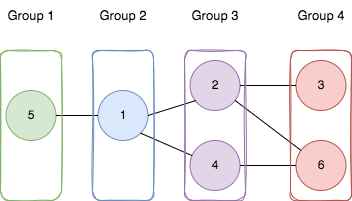| title | description | keywords | ||||||||
|---|---|---|---|---|---|---|---|---|---|---|
2493. 将节点分成尽可能多的组 |
LeetCode 2493. 将节点分成尽可能多的组题解,Divide Nodes Into the Maximum Number of Groups,包含解题思路、复杂度分析以及完整的 JavaScript 代码实现。 |
|
🔴 Hard 🔖 广度优先搜索 并查集 图 🔗 力扣 LeetCode
You are given a positive integer n representing the number of nodes in an
undirected graph. The nodes are labeled from 1 to n.
You are also given a 2D integer array edges, where edges[i] = [ai, bi]
indicates that there is a bidirectional edge between nodes ai and bi.
Notice that the given graph may be disconnected.
Divide the nodes of the graph into m groups (1-indexed) such that:
- Each node in the graph belongs to exactly one group.
- For every pair of nodes in the graph that are connected by an edge
[ai, bi], ifaibelongs to the group with indexx, andbibelongs to the group with indexy, then|y - x| = 1.
Return the maximum number of groups (i.e., maximumm ) into which you can
divide the nodes. Return -1 if it is impossible to group the nodes with
the given conditions.
Example 1:
Input: n = 6, edges = [[1,2],[1,4],[1,5],[2,6],[2,3],[4,6]]
Output: 4
Explanation: As shown in the image we:
- Add node 5 to the first group.
- Add node 1 to the second group.
- Add nodes 2 and 4 to the third group.
- Add nodes 3 and 6 to the fourth group.
We can see that every edge is satisfied.
It can be shown that that if we create a fifth group and move any node from the third or fourth group to it, at least on of the edges will not be satisfied.
Example 2:
Input: n = 3, edges = [[1,2],[2,3],[3,1]]
Output: -1
Explanation: If we add node 1 to the first group, node 2 to the second group, and node 3 to the third group to satisfy the first two edges, we can see that the third edge will not be satisfied.
It can be shown that no grouping is possible.
Constraints:
1 <= n <= 5001 <= edges.length <= 10^4edges[i].length == 21 <= ai, bi <= nai != bi- There is at most one edge between any pair of vertices.
给你一个正整数 n ,表示一个 无向 图中的节点数目,节点编号从 1 到 n 。
同时给你一个二维整数数组 edges ,其中 edges[i] = [ai, bi] 表示节点 ai 和 bi 之间有一条 双向
边。注意给定的图可能是不连通的。
请你将图划分为 m 个组(编号从 1 开始),满足以下要求:
- 图中每个节点都只属于一个组。
- 图中每条边连接的两个点
[ai, bi],如果ai属于编号为x的组,bi属于编号为y的组,那么|y - x| = 1。
请你返回最多可以将节点分为多少个组(也就是最大的 m )。如果没办法在给定条件下分组,请你返回 -1 。
示例 1:
输入: n = 6, edges = [[1,2],[1,4],[1,5],[2,6],[2,3],[4,6]]
输出: 4
解释: 如上图所示,
- 节点 5 在第一个组。
- 节点 1 在第二个组。
- 节点 2 和节点 4 在第三个组。
- 节点 3 和节点 6 在第四个组。
所有边都满足题目要求。
如果我们创建第五个组,将第三个组或者第四个组中任何一个节点放到第五个组,至少有一条边连接的两个节点所属的组编号不符合题目要求。
示例 2:
输入: n = 3, edges = [[1,2],[2,3],[3,1]]
输出: -1
解释: 如果我们将节点 1 放入第一个组,节点 2 放入第二个组,节点 3 放入第三个组,前两条边满足题目要求,但第三条边不满足题目要求。
没有任何符合题目要求的分组方式。
提示:
1 <= n <= 5001 <= edges.length <= 10^4edges[i].length == 21 <= ai, bi <= nai != bi- 两个点之间至多只有一条边。
-
构建邻接表:
使用邻接表存储图结构,方便快速遍历邻居节点。 -
BFS 检测奇环:
- 使用
BFS遍历每个连通分量,记录节点到根节点的深度。 - 如果遍历过程中发现 相邻节点深度之差为奇数,说明存在奇数环,不符合要求,直接返回
-1。
- 使用
-
计算最大组数:
- 对于每个连通分量,选取不同的起点进行
BFS,记录最大深度。 - 连通分量的最大深度即为当前分量的组数,累加到结果中。
- 对于每个连通分量,选取不同的起点进行
-
返回结果:
输出所有连通分量的最大可能分组数量。
- 时间复杂度:
O(n + m),其中n为节点数,m为边数。构建邻接表 + 遍历所有连通分量 + BFS 检查节点。 - 空间复杂度:
O(n + m),存储邻接表、访问标记和节点深度。
/**
* @param {number} n
* @param {number[][]} edges
* @return {number}
*/
var magnificentSets = function (n, edges) {
// 构建邻接表
const graph = Array.from({ length: n + 1 }, () => []);
for (const [u, v] of edges) {
graph[u].push(v);
graph[v].push(u);
}
const visited = Array(n + 1).fill(false);
let maxGroups = 0;
// BFS 检查是否有奇环,同时计算深度
const bfs = (start) => {
const queue = [[start, 1]];
const nodeDepths = new Map();
let maxDepth = 1;
while (queue.length) {
const [node, depth] = queue.shift();
if (nodeDepths.has(node)) {
if ((nodeDepths.get(node) - depth) % 2 !== 0) return -1; // 奇环
continue;
}
nodeDepths.set(node, depth);
maxDepth = Math.max(maxDepth, depth);
for (const neighbor of graph[node]) {
if (!nodeDepths.has(neighbor)) {
queue.push([neighbor, depth + 1]);
}
}
}
return maxDepth;
};
// 遍历所有连通分量
for (let i = 1; i <= n; i++) {
if (!visited[i]) {
const componentNodes = [];
const queue = [i];
visited[i] = true;
// 获取连通分量中的所有节点
while (queue.length) {
const node = queue.shift();
componentNodes.push(node);
for (const neighbor of graph[node]) {
if (!visited[neighbor]) {
visited[neighbor] = true;
queue.push(neighbor);
}
}
}
let bestDepth = 0;
for (const node of componentNodes) {
const depth = bfs(node);
if (depth === -1) return -1;
bestDepth = Math.max(bestDepth, depth);
}
maxGroups += bestDepth;
}
}
return maxGroups;
};| 题号 | 标题 | 题解 | 标签 | 难度 | 力扣 |
|---|---|---|---|---|---|
| 102 | 二叉树的层序遍历 | [✓] | 树 广度优先搜索 二叉树 |
🟠 | 🀄️ 🔗 |
| 785 | 判断二分图 | 深度优先搜索 广度优先搜索 并查集 1+ |
🟠 | 🀄️ 🔗 | |
| 2608 | 图中的最短环 | 广度优先搜索 图 |
🔴 | 🀄️ 🔗 |
